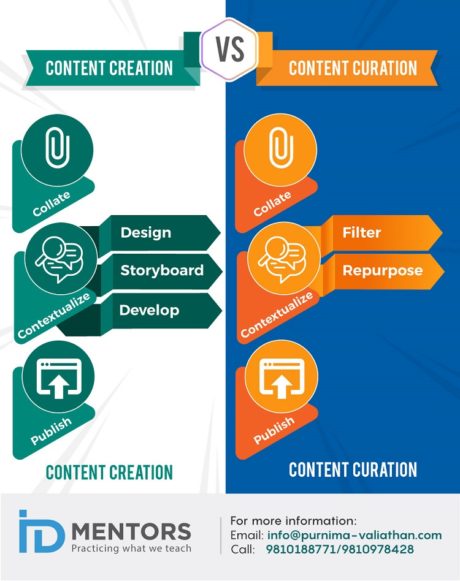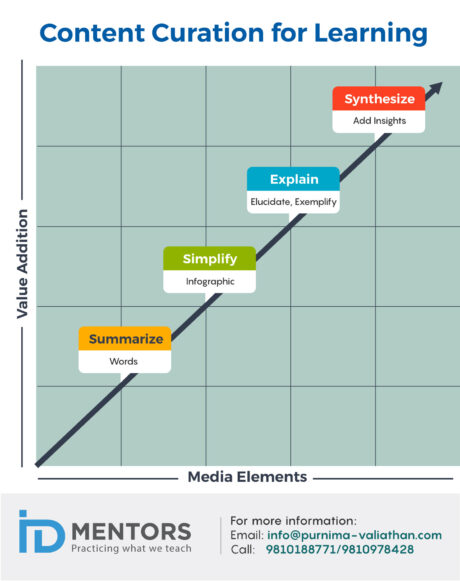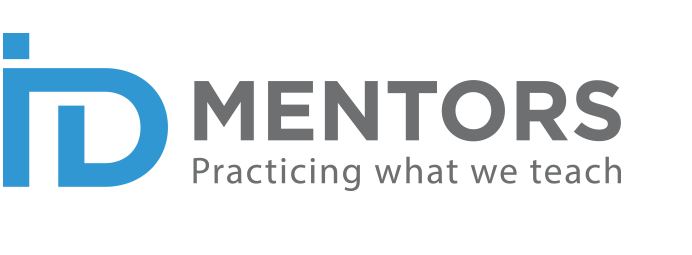Understanding Curation
We exist in a world where there is an overload of information. How do you cut through all the noise and get to identify the information that is reliable, relevant and suits your requirement and context? This is the need that is addressed through Content Curation. Let’s look at a couple of definitions of this term.
- Wikipedia: “the collection and sorting of information”
- Carr (2012): “The idea behind curation, sometimes called aggregation, is linking and or excerpting the work of others”
Now let’s derive some guidelines from the two definitions by focusing on the keywords, therein – collection, sorting, aggregation and excerpting. Looking at these keywords, it appears that Content Curation involves teh following:
- Finding the best information from various sources
- Filtering and identifying the most relevant from the collected information
- Sharing it with the relevant people through the right platform
- Adding value to the information by summarizing it or adding insights
Curating content is beneficial in many ways. It is a means to keep you updated, share knowledge with others and reduce the time and effort required to develop new content.
There are various platforms and tools that you can use to curate content. Pinterest, Twitter, LinkedIn, and Facebook are social media platforms that you can use to curate content. WordPress, Blogger and Sharepoint are websites that may be used for curation. You can also use Mailchimp, which is an online marketing platform, to publish and share newsletters. In addition, bookmarking, adding hashtags to posts on social media, or sticky notes on webpages are different ways of curating too.
Analysis from a Learning Perspective
I am not sure but I think the term, Content Curation originated in the marketing field. So basically, in marketing, businesses collect content related to a specific topic that targets a certain audience, add expert comments and viewpoints to this and then share it online. The purpose of content curation here is to enhance branding, generate leads, acquire customers and sometimes even provide customer service.
However, content curation for learning is different – because the purpose here is to help people learn as against simply inform. Instructional designers have already been doing quite a few tasks that are part of the content curation process. So how is it different from content creation, which is what we mostly do? Let’s see.
In both cases, we do collate, contextualize and publish content. That’s what I see as the commonality. The key difference between the two lies in the sub-tasks involved in contextualizing. While you just filter and re-purpose in the case of curation, to create content you have to design, storyboard, and develop media and other resources.

Curating Content for meeting Learning Objectives
Contextualizing content for learning may be simpler than creating content, but it still involves a fair amount of work. The first step is to filter the content that you have collated by identifying the ones that are most relevant to meet a learning need. Next, you need to re-purpose it to meet the learning objective. This may be done in any one of the following ways:

- Summarize: Summarize the key message from the collated material and provide links to original works. The summary may be a simple one-paragraph overview to the topic/concept or a list of key points from each content piece. Note that in this case, your effort is the bare minimum because you reproduce the material in only words, and no media.
- Simplify: Paraphrase the curated material in the form of an infographic for easy comprehension and quick recall. Since this involves repurposing original content by rewriting and adding graphics, it will require more effort.
- Explain: Elucidate the essence of the collated content pieces and add examples where needed. You can create this in a graphics and text format or a short video. Since you are adding much more value to the original content pieces, this strategy will involve more effort than summarizing and simplifying.
- Synthesize: Gain insights from the collated content and share these via text and media. You may create a short video to share the insights or a small write-up with media elements. The value addition in this case is extremely high….you may add value from a content perspective as well as through media elements, such as a video.
External Resources
- Here is a presentation, How to Curate by David Kelly. The presentation explains what curation is and details the three stages of the curation process, which are Listen, Analyze and Share.
- If you want another perspective on this topic, here is a write-up on Content Curation by Mike Taylor, a learning consultant.
Tools
Type
Companies
Product Categories
Recent Comments
- Sunidhi on ID @ Work for Practitioners
- Prithwijit Baksi on Gamification in Learning
- Prithwijit Baksi on Scripting an Instructional Unit
- Sonam Sharma on Introduction to Instructional Writing
- Sonam Sharma on Multimedia Principles
- Sunidhi on Introduction to Instructional Writing
- Purnima Valiathan on Basic English Assessment
- Raheli on Multimedia Principles
- Sunidhi on Multimedia Principles
- Shipra on Cognitive Load Theory



0 responses on "Learning Content Curation"